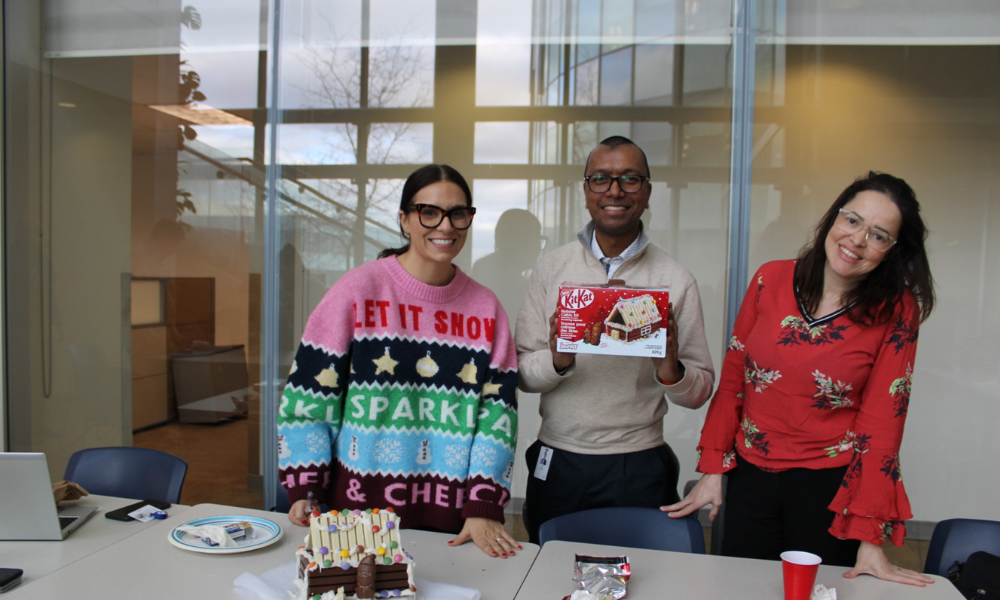HR leader: Peter Halder of BASF discusses data, total rewards and national pharmacare

Looking back, Peter Halder says his career in HR didn’t turn out quite as he expected.
“I definitely didn’t foresee that there’ll be so many fires to put out,” says the head of HR at BASF. “There’s a lot of different moving parts. It’s not as structured as I probably thought it would be. There’s a lot of fluidity that’s required on our behalf, as HR professionals, to really customize things a lot.”
Being creative and identifying the best strategies – whether that’s in the total rewards or the development space – has been more complex than anticipated, says Halder.
“But it’s been rewarding, definitely,” he says, citing the example of people thanking him for a particular program that’s helped them or their family.
“That’s the element that I think I’ve found to be extremely satisfying.”
From sales to people leader
Halder began his career in sales. But that didn’t last long after he realized the importance of people and skills when it came to business success.
“I was moving around a little bit and traveling and observing the people that I was working with, or some people that I had to manage or lead, and it occurred to me, people are such an important element to what we do.
“And, obviously there's technology and AI... but who we are, how we develop our skills, or what skills do we need to succeed, how do we get the most productive version of ourselves out there — that always intrigued me.”
These revelations led Halder to wish for more tools, resources and a “stronger say” in how things worked, he says, which increased his interest in helping individuals develop.
“I wanted to go into learning and development, train folks on a plethora of topics, meaning leadership and things like that. So, that was an interest that sparked inside of me.”
Unique cultures at Chevron, GlaxoSmithKline
Halder’s first real job in HR started at Chevron where he began as HR administrator and held the title of payroll and total remuneration advisor by the time he left more than four years later.
That role was more about compensation and benefits, but Halder says he enjoyed the people element “and being able to identify and understand and strategize ‘What is it that’s going to take us to be a more productive, motivated version of ourselves, every day?’”
He went on to work at GlaxoSmithKline where he was HR operations manager and rewards lead, and then Philip Morris International as team leader, P&C operations, rewards and information management.
And looking back at these well-known companies, Halder says he’s learnt a lot about the unique cultures found in organizations.
“Every industry works in a very different environment, [with a] different set of customers, and we're all humans at the end of the day, that consume these products or these commodities or services. But how we get the product to them, and how we strategize to get to them, and… how every organization's culture is different in that, let's say a value chain, is quite unique.”
Those insights helped Halder build a strong foundation for working in a global world, he says, especially when it comes to human capital and what it takes to succeed.
“I know now that GSK would look at their employees through this lens and why, versus Chevron through this lens and why, but when you're in there, it's hard to see the why. When you come out and, put these all side by side, it's a great learning journey. So, I'm very privileged to have had that.”
Head of people at BASF
Almost four years ago, Halder signed on with BASF, where he has progressed from senior specialist of total rewards to head of people, as of June 2024.
Founded in Germany nearly 160 years ago, BASF is the largest chemical producer in the world and has customers in over 190 countries, with more than 100,000 employees worldwide – including 1,300 in Canada.
The company offered Halder a holistic role, he says, which was a big part of the appeal.
“They said, ‘We’re looking for somebody who can help design our total reward strategy.’ And I said, ‘Sign me up.’ I want to be responsible for that strategy, I want to see it out. I want to look back at it three years later to say, ‘Alright, I’m still here and it’s working’ or ‘It’s not working’ and how do we pivot?”

A big part of the reason why Halder likes total rewards is the data aspect.
“It’s more numeric, quantitative. I always felt that numbers don’t lie. If you’ve got the math right, the numbers are pretty solid.”
That can then extrapolate trends about an organization, he says.
“That always gets my juices flowing. I look at those charts and data and [think]: ‘Here’s what I can derive from it’ versus a casual conversation about something… [that] could be your opinion.”
Balancing total rewards with employee preferences
But it can still be a challenge, as benefits mean different things to different individuals, says Halder. A pension, for example, may be important to older workers while younger ones prefer gym discounts.
“We look at wellbeing as financial, mental and physical and emotional or psychological. It's so broad, and it's hard to really say, ‘This is a good plan for everybody.’ It's not, so I think the challenge of total rewards certainly is offering flexibility,” he says.
“HR has to be very agile, but also very smart in understanding what employees want and being able to provide that within your budgetary constraints.”
Finding that balance doesn't happen overnight, says Halder, and it requires tracking the data and making progressive improvements — and a lot of conversations with employees. That can include “myth-busting” segments with employees to provide insights on the benefits strategy, which includes gamification for better engagement, he says.
BASF tries to be both competitive and creative in the total rewards space, says Halder, in keeping an eye on the market. That can mean a wellness and fitness reimbursement program for gym equipment or camping fees, along with breast pumps that aren’t covered by an insurance policy, and possible benefits around pet wellness.
“You're working on improving everybody's salaries every year, but you're also finding ways to make it cheaper for them to avail regular services. And that journey continues,” he says.
Also a priority? Employee experience, by “heavily” investing in technologies to boost engagement in systems and platforms, says Halder.
“There's a lot of self-service options that can be introduced, and we're looking at making that space a lot better for our colleagues.”
Pharmacare and employee benefits
With the recent passage of the national pharmacare plan in Canada, employees' prescription drug costs could decrease as it would cover medications currently included in employer-sponsored benefits.
“This could provide an opportunity for employers to adjust the design of the group benefits plans they offer employees and reallocate resources to areas not covered by the pharmacare plan,” says Halder.
Another point to consider is standardization, he says, as a national plan could create more uniform coverage for medications nationwide.
“This might simplify things for employees, making understanding what’s covered under the national plan versus employer-sponsored benefits easier.”
And the improved access to medications could also lead to better health outcome, as employees facing fewer financial barriers are more likely to stick to their prescribed treatments.
“This could translate into fewer sick days and increased productivity,” says Halder.
Finally, the pharmacare plan could lead to shifts in employees' expectations of their employer-sponsored health benefit.
“they may prioritize other health and wellness support over drug coverage, seeking benefits that enhance their overall well-being, he says. “We might see the introduction of new wellness initiatives, preventive care programs, and health management strategies that go beyond just prescription drugs.”



